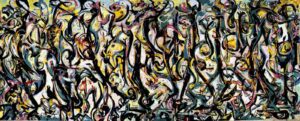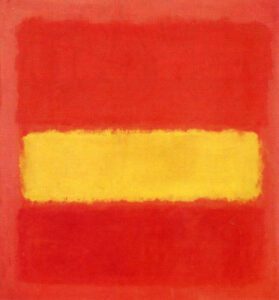Stephen F. Eisenman sees Causal Connection Between The “Anthropocene” and Abstract Expressionism

The decade and a half between 1945 to 1960, the heyday of Abstract Expressionism, may turn out to be the most consequential in the history of the planet. That’s when the human impact on nature became so great that the survival of life itself was threatened.
The U.S. dropped atomic bombs on Hiroshima and Nagasaki in 1945. Soon after, both the U.S. and Russia tested hydrogen weapons. By 1960, nuclear residues were detectable everywhere, including in breast milk. In 1962, during the Cuban Missile Crisis, the world teetered on the edge of destruction.
The same period saw accelerated economic growth and equally rapid degradation of the environment. Every graph of socio-economic trends shows a precipitous rise in the use of energy, water, transportation, metals, minerals and fertilizer. And following from these, increased ocean acidification, precipitous loss of tropical forests, elevated levels of atmospheric carbon dioxide and methane, and higher temperatures.
Scientists have determined the changes were so dramatic that the period marked the start of the most recent geologic epoch, the Anthropocene, when earth systems no longer followed their natural course but were instead directed by humans.
What does the Anthropocene have to do with Abstract Expressionism? Put simply, one was precondition of the other. The energy and destructiveness of the former finds expression in the latter.

Clyfford Still’s paintings, such as PH-123 (1954), included in the recent, Royal Academy exhibition, “Abstract Expressionism”, suggest post-apocalyptic landscapes made of shards, scars and geologic ruins. Mark Rothko’s stacked rectangles are invitations to another world. But once entering, we detect a disturbing radioactive glow – they are a refuge and a tomb.
Willem de Kooning rendered women and urban life as a sum of derangements – the body and the city cut in pieces. The Art Institute of Chicago’s great de Kooning, Excavation (1950), not lent to London, is the paradigmatic example. Figure presses against figure, surface against depth and edge against center in a battle of all against all. Barnett Newman both reduced painting to elemental geometries and expanded it to global scale.
With his mature, nearly black rectangles such as Abstract Painting (1956), Ad Reinhardt sought to eliminate personality and history in the name of a refined and purified art of negation. More than any of the others, Jackson Pollock represented the frenzy and fallout of his age. When he described his paintings as “energy and motion made visible” we should take him literally. They were derived from the energy of atomic power, fossil fuels and the motion of fast cars on new highways. Pollock’s was not an explicitly political art – it was a visualization of the uncertainty, danger and dynamism of the age.
The Abstract Expressionists represented the last generation of Americans to experience in their youth a society not yet fully capitalist. And their biographical particulars made them particularly sensitive to this historical circumstance. Rothko was born in Dvinsk in 1903, in pre-Revolutionary Russia and migrated to Portland, Oregon at age ten. In his teens, he heard speeches by Bill Haywood, Emma Goldman and the other anarchists associated with the IWW. By the late 1940s, he had fully abjured representational art.
Gorky was a year younger than Rothko, and born in the village of Khorgom, in what is now Turkey. His family fled the Armenian genocide in 1915, and nearly his entire career was based upon memories or dreams of that distant and haunted land. The Orators (1947) and The Limit (1947), both included in the exhibition, contain vestiges of pre-industrial farm machinery and suggestions of cultivated fields.
De Kooning, one of Gorky’s closest friends, was born in Rotterdam, also in 1904, and arrived in the US in 1927 as a stowaway. He worked as a house painter and odd-jobber before joining the Federal Art Project. His mature art was existential, affirming the value of being over meaning. By the late 1940s, abstraction and representation were the same to him – affirmations of sheer existence and nothing more.
Pollock was born in Cody, Wyoming and grew up Arizona and Southern California. He was expelled from Manual Arts High School in L.A. for being a communist. Later, he spent time in the Southwest, learning about Native American culture. His drip technique was inspired in part by Navajo sand painting and in part by the rhythms and movements of modern dance.

Pollock was the pre-eminent artist of the movement and the one who best apprehended the dawning Anthropocene. The titles of his pictures – Eyes in the Heat (1946), Shimmering Substance (1946), Alchemy (1947), Lucifer (1947). Vortex, (c. 1947), Phosphorescence and Enchanted Forest, (1947) – allude to the nearly unfathomable power and destructiveness of the period.
“The modern painter,” Pollock told an interviewer in 1950, “cannot express this age–the airplane, the atom bomb, the radio–in the old forms of the Renaissance or of any other past culture.” His medium was automobile enamel, aluminum paint, and thinned oil paint and turpentine, applied to unprimed and un-stretched canvas. Rather than use brushes, he employed sticks and open cans to drip, pour, and ladle paint in loops, ribbons, whorls, coils and splashes. The colors are un-natural and automotive, and phrases like “pink Cadillac”, or “silver- trimmed Studebaker” come to mind when you see No. 1, 1949 (Museum of Contemporary Art, Los Angeles), which is not in the RA show, and Blue Poles (1952), which is.
Securing Blue Poles for “Abstract Expressionism” was a coup. It is big, fragile and the best artwork in Australia. The picture was dramatically lit at the RA and easily overwhelmed the eight-foot Mural (1943) hung on the opposite wall. Blue Poles has a clotted yet animated surface, and every inch is covered by tightly woven skeins of paint. The composition however has a steady rhythm supplied by the regularly spaced, diagonal poles that resemble the flagged spears used by picadors in Spanish bullfights.
Had Pollock been reading Hemingway’s “Death in the Afternoon” and poured over its grisly illustrations? Peggy Guggenheim was their mutual friend, and it is impossible to imagine that the writer and the artist didn’t know each other’s works. But whereas Hemingway in the 1950s, for all his celebrity, remained a creature of the literary salons that gave him his start, the younger Pollock was a product of the post-war American imperium. He couldn’t have recognized “anthropocene” if he had seen it in a dictionary, but his restless, energetic, anxious and refulgent art made him its early avatar.
The curators at the Royal Academy generally occluded this history, focusing instead on individual careers and personalities. Most of the galleries were devoted to works by single artists, though some were an omnibus, chock-a-block with artists left over from the main account: Philip Guston, Jack Tworkov, William Baziotes, Joan Mitchell, Lee Krasner, Norman Janet Lewis and others.
But lacking a number of essential works, such as De Kooning’s Gotham News or the great Pollocks from MOMA or the Met, or the right combination of pictures, these mini-retrospectives are often unsatisfying. As a result, the exhibition was less than the sum of its parts. Consider the examples of Rothko and Gorky.

Rothko was represented by eight canvases hung in an octagonal room in the middle of the exhibition space. The intended effect was presumably something like the Seagram Murals at the Tate Modern in London, the Rothko Chapel in Houston, or the Rothko Room at the Phillips Museum in Washington, D.C. But in those cases, the artist either created works to be hung in an ensemble or, in the case of Phillips, helped with the selection and installation. He believed not only that his works were intolerant of proximity to paintings by his contemporaries, but sometimes even other works by him!
His caution was unfortunately validated at the Royal Academy by the placement of Yellow Band (1956) beside Untitled (1954). The anti-freeze green of the latter, surrounding a central field of salmon-pink is already a difficult combination. Seen beside the mustard yellow, orange-red and salmon of the former, it becomes incoherent. Instead of connoting, as the late John Berger wrote, “an intense premonition, as it might have occurred in the flash of the Big Bang,” the Rothko installation comprised an assemblage of discrete and clashing colors. Not so much premonition as competition.
Gorky was well represented with a Picasso-inspired Still Life on a Table (1936-7), the great Self-Portrait [with no hands] from 1937, the liquid and dreamlike Water of the Flowery Mill (1944) and The Limit, 1947. But even here, segregated from contemporary pictures by Baziotes, Lewis, Rothko, Pollock, Krasner, Gottlieb and even De Kooning, renders the Gorky pictures homeless. Their engagement with myth and what Rothko and Gottlieb called “the tragic and the timeless” is obscured. (The paucity of works by Norman Lewis – just one small picture – is scandalous. The recent exhibition in Chicago proved the breadth and depth of his vision.)
More than 60 years have passed since Pollock’s death in a car crash. In that time, the authority of his work and that of his contemporaries has only grown. The reason is not simply their intelligence and originality, but our own recognition of the salience of their historical moment and its environmental legacy. We are all Abstract Expressionists now – children of the Anthropocene — and we had better come to a reckoning with that fact.
(London, Royal Academy, September 24, 2016 to January 2, 2017; Bilbao, Spain, Guggenheim Museum, February 4 to June 4, 2017.)
Stephen Eisenman is a professor of art history at Northwestern University and a contemporary Art expert
Volume 31 no 4 March / April 2017 pp 10-12
